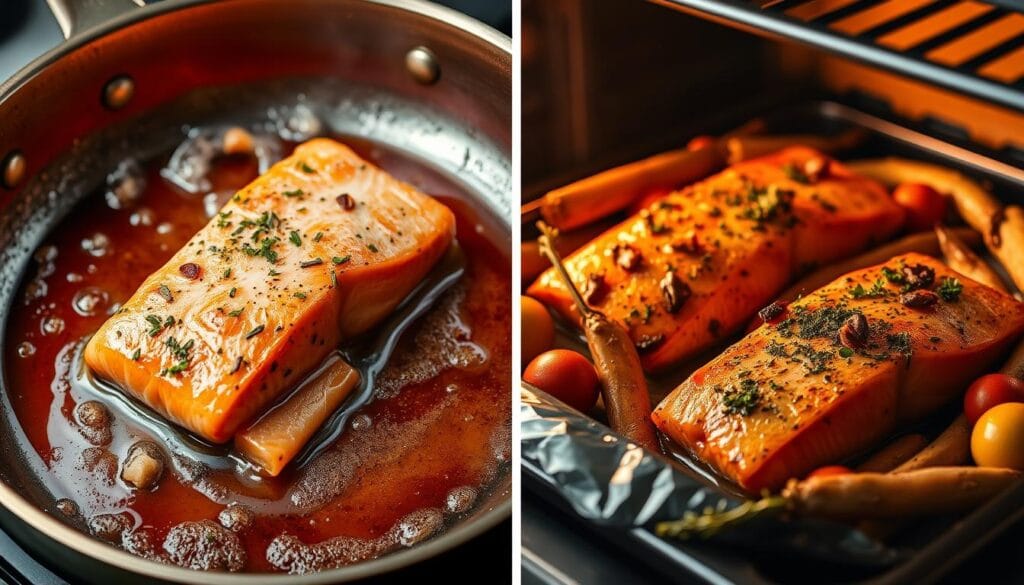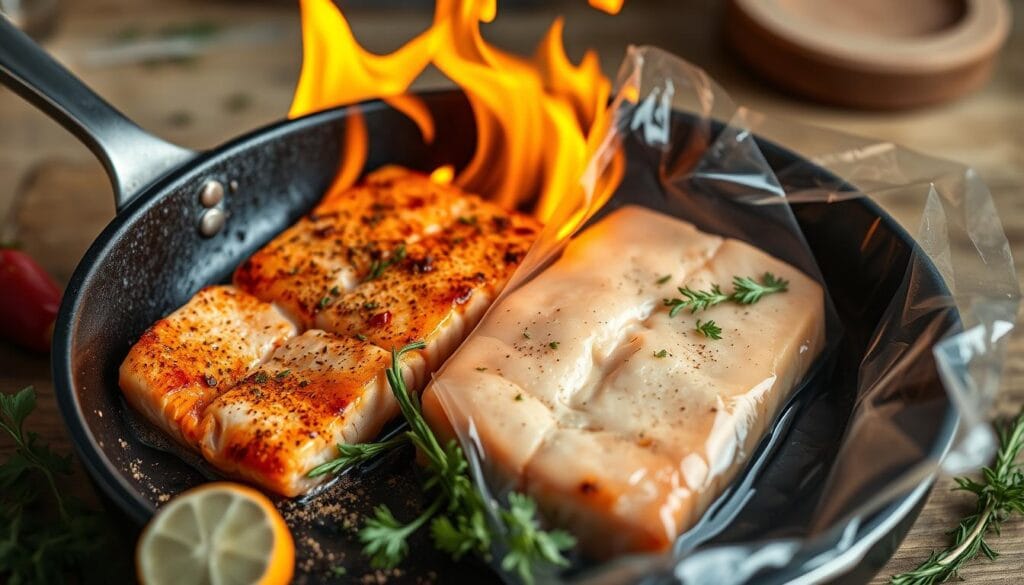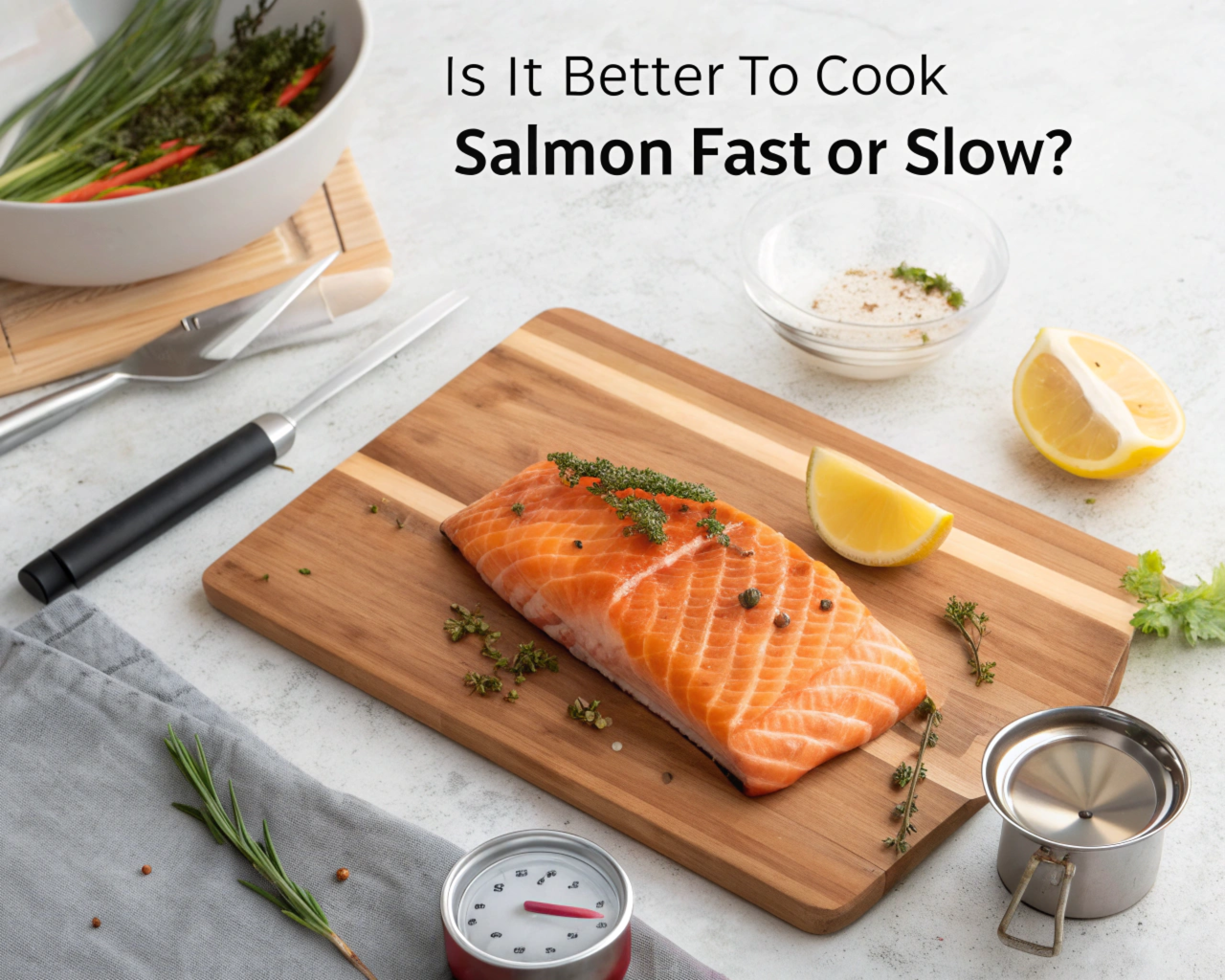Cooking salmon perfectly can be a challenge, and a common question many cooks face is: Is it better to cook salmon fast or slow? The method you choose has a significant impact on the taste, texture, and overall quality of your dish. In this guide, we’ll dive into the pros and cons of both fast and slow cooking methods, backed by the science of heat and timing. Whether you’re looking for a quick weeknight dinner or a melt-in-your-mouth delicacy, this guide will help you master the art of cooking salmon to suit your preferences.

Table of contents
Understanding Salmon Cooking Methods: Fast vs. Slow
Cooking salmon well needs you to know the science behind different ways to cook it. You might like a quick sear or a slow-roasted salmon. The time and heat it gets can change its texture and how moist it stays.
The Science Behind Cooking Times
The secret to great salmon is finding the right mix of time and heat. Quick methods like pan-searing or broiling use high heat to cook the salmon fast. This helps keep its juices inside. Slow methods, like oven-roasting, cook the salmon slowly. This makes it tender and flaky.
How Temperature Affects Salmon Texture
The cooking temperature greatly changes the salmon’s texture. High heat makes the proteins tight, making the salmon firm. Lower heat lets the proteins relax, making it soft and moist.
Moisture Retention in Different Methods
Quick cooking, like pan-searing, makes the outside crispy but can dry out the inside. Slow cooking, like poaching or oven-roasting, keeps the salmon moist. This makes it juicy and tender.
| Cooking Method | Temperature | Texture | Moisture Retention |
|---|---|---|---|
| Pan-Searing | High (400°F+) | Firm, Compact | Moderate |
| Broiling | High (500°F+) | Firm, Caramelized | Low |
| Oven-Roasting | Moderate (350°F) | Flaky, Tender | High |
| Poaching | Low (140-180°F) | Delicate, Soft | High |
Knowing the science of salmon cooking and how temperature effects on salmon helps you cook it perfectly. You’ll get the right texture and moisture every time.

“The key to cooking salmon is to find the right balance between time and temperature to unlock its natural flavors and textures.”
Is it better to cook salmon fast or slow?
There’s a long debate about cooking salmon fast or slow. Chefs and home cooks have their own opinions. The best method depends on what you like and what you want to achieve.
Fast cooking, like pan-searing or broiling, seals in salmon’s flavors and juices. It makes the fish tender and juicy. This method is quick and easy, perfect for weeknights.
Slow cooking, such as baking or poaching, keeps salmon tender and buttery. It cooks the fish evenly, so it’s never overcooked. This method is great for tender salmon.
“The key to perfect salmon is finding the right balance between speed and tenderness. Both fast and slow cooking methods have their advantages, and the optimal approach will depend on your personal taste preferences and the specific dish you’re preparing.”- Chef Emily Rodgers
Choosing between fast or slow cooking is up to you. Fast cooking is good when you’re in a hurry. Slow cooking is better for tender and flavorful salmon. Try both to find your favorite way to cook salmon.
Quick-Cooking Techniques for Perfect Salmon: Is it Better to Cook Salmon Fast or Slow?
Cooking salmon quickly is key, especially on busy nights. There are fast methods to get tender, flavorful salmon. Chefs like Gordon Ramsay use pan-searing, while high-heat roasting is quick and easy.
Pan-Searing Method
Pan-searing is a fast way to cook salmon. Dry the fillets and season with salt and pepper. Heat oil in a skillet over medium-high.
When the oil shimmers, add the salmon, skin-side down. Cook for 3-4 minutes until the skin is golden. Flip and cook another 2-3 minutes until it’s opaque and flakes easily.
Broiling Benefits
Broiling, an underutilized yet effective method, exposes salmon to intense heat, resulting in a smoky, caramelized exterior in just 8–10 minutes. To get additional inspiration for bold yet easy dishes, explore easy salmon crock-pot recipes for perfect dinners, which offer simplicity and flavor in one.
High-Heat Roasting Tips
High-heat roasting is easy and hands-off. Preheat your oven to 450°F (232°C). Line a baking sheet with foil or parchment paper. Dry and season the salmon, then roast for 12-15 minutes until it’s cooked through.
Choose your quick-cooking method wisely. Pay attention to the salmon’s internal temperature and cooking time. With these methods, you can enjoy restaurant-quality salmon at home quickly.
Slow-Cooking Methods for Tender Results: Is it Better to Cook Salmon Fast or Slow?
Slow-cooking salmon can make it incredibly tender and moist. Techniques like oven-baking at low temperatures and poaching are great for this. They bring out the best in this versatile fish.
Oven-baking salmon at 275°F to 325°F cooks it slowly. This keeps its juices and texture intact. It’s a patient process, but the salmon turns out flaky, tender, and full of flavor.
Poaching is another top choice for salmon. It cooks the fish in a flavorful liquid, like broth or white wine. This method keeps the salmon moist and tender, thanks to the low heat.
For more slow-cooking ideas, check out what is the best cooking method for salmon, a guide that emphasizes achieving tenderness and flavor balance.
- For best results with slow-cooked salmon, aim for internal temperatures between 125°F to 140°F.
- Slow-cooking times can range from 30 minutes to an hour, depending on the thickness of the salmon fillets.
- Basting the salmon with the cooking liquid or a flavorful sauce can further enhance the tenderness and flavor.
Slow-cooking unlocks the full potential of slow-cooked salmon. It makes a dish that’s both delicious and beautiful.
Essential Preparation Steps Before Cooking: Is it Better to Cook Salmon Fast or Slow?
Getting your salmon just right is all about preparation. Whether you’re searing it quickly or roasting it slowly, marinating, seasoning, and warming it up are crucial. These steps can greatly improve your salmon’s taste and texture.
Marination Techniques
Marinating salmon adds flavor and makes it tender. You can use simple lemon-herb mixtures or more complex Asian flavors. Make sure to marinate for 30 minutes to 2 hours to avoid it becoming too soft.
Seasoning Guidelines
Seasoning your salmon right can really bring out its natural taste. A mix of salt, pepper, garlic, and dill is a good starting point. For something bolder, try a dry rub with paprika, cumin, and brown sugar. Season all sides to ensure flavors are evenly spread.
Temperature Considerations
Letting your salmon come to room temperature before cooking is key. It helps cook evenly, making it moist and flaky. Don’t put cold salmon in a hot pan or oven, as it can overcook the outside before the inside is done.
| Marination Tip | Seasoning Blend | Temperature Guidance |
|---|---|---|
| Soak salmon in a mixture of lemon juice, olive oil, and herbs for 30-60 minutes. | Rub salmon with a blend of salt, pepper, garlic powder, and dried dill. | Allow salmon to sit at room temperature for 30 minutes before cooking. |
By following these steps, you’ll cook salmon that’s tender, flavorful, and perfectly cooked.
Professional Chef Tips for Cooking Salmon: Is it Better to Cook Salmon Fast or Slow?
Professional chefs offer a lot of expert salmon cooking advice. They teach us how to pick the best fish and get a perfect sear. Their chef-approved salmon techniques help make amazing salmon dishes.
Top chefs say to choose high-quality, sustainable salmon. Look for fillets that are bright, firm, and smell fresh. Stay away from dull or discolored fish, as they’re older and less fresh.
- Gently pat the salmon dry with paper towels before cooking to ensure a crisp, golden-brown sear.
- Use a heavy-bottomed pan or cast-iron skillet to achieve a perfect sear on the salmon’s surface.
- Baste the salmon with butter or oil during the cooking process to keep it moist and flavorful.
Another key tip is to check the salmon’s internal temperature. Use a digital thermometer to aim for 125°F to 130°F. This ensures it’s cooked just right, without drying out.
| Recommended Internal Temperature | Doneness Level |
|---|---|
| 125°F to 130°F | Medium-rare to Medium |
| 135°F to 140°F | Medium to Medium-well |
| 145°F and above | Well-done |
By following these expert salmon cooking advice and chef-approved salmon techniques, you can make your salmon dishes as good as a restaurant’s. With practice and attention to detail, anyone can cook perfect salmon.
“The key to cooking salmon is to respect the natural flavors of the fish. Use simple seasoning and techniques to let the salmon shine.” – Chef Julia Child
Common Mistakes to Avoid When Cooking Salmon; Is it Better to Cook Salmon Fast or Slow?
Cooking salmon can be tricky. Even a small mistake can ruin the dish. Home cooks need to watch out for temperature control errors, timing issues, and seasoning mishaps. These can make salmon dry and taste bad.
Temperature Control Errors
Keeping the right temperature is key when cooking salmon. If it gets too hot, it dries out and tastes bad. If it’s not hot enough, it’s not safe to eat. Use a meat thermometer to make sure it reaches 145°F (63°C).
Timing Issues
Salmon cooks fast, especially at high heat. Watch it closely to avoid it getting too dry. Follow the recipe and adjust cooking times based on the salmon’s thickness.
Seasoning Mishaps
Seasoning is important to enhance salmon’s flavor. But too much or the wrong seasoning can ruin it. Try different herbs, spices, and citrus to find the right mix.
By avoiding these common mistakes, you can make delicious salmon every time.
Best Tools and Equipment for Salmon Preparation: Is it Better to Cook Salmon Fast or Slow?
Cooking salmon to perfection needs the right tools and equipment. Invest in top-notch kitchen essentials for delicious, restaurant-quality results. Specialized fish spatulas and instant-read thermometers are key to mastering salmon preparation.
Indispensable Salmon Cooking Tools
- Fish Spatula – This long, thin spatula is designed to gently lift and turn delicate salmon fillets without tearing the flesh.
- Instant-Read Thermometer – An essential tool for ensuring your salmon is cooked to the perfect internal temperature, preventing over or undercooking.
- Non-Stick Skillet – A high-quality non-stick pan will prevent salmon from sticking and make cleanup a breeze.
- Baking Sheet – A sturdy baking sheet is perfect for oven-roasting salmon, allowing the heat to evenly distribute around the fillets.
- Kitchen Shears – Sharp scissors make it easy to trim and portion salmon before or after cooking.
| Tool | Benefit |
|---|---|
| Fish Spatula | Gently lifts and turns delicate salmon without tearing |
| Instant-Read Thermometer | Ensures salmon is cooked to the perfect internal temperature |
| Non-Stick Skillet | Prevents salmon from sticking and makes cleanup easy |
| Baking Sheet | Ideal for oven-roasting salmon with even heat distribution |
| Kitchen Shears | Simplifies trimming and portioning salmon |
Having these salmon cooking tools and kitchen equipment for fish in your kitchen makes preparation easier. It ensures delicious salmon every time.
Conclusion: Is it Better to Cook Salmon Fast or Slow?
Mastering salmon cooking means knowing both fast and slow methods. Each method has its own benefits. You can get the texture, flavor, and doneness you want.
Do you like a quick pan-sear or a slow-roasted fillet? Salmon cooking is versatile. You can choose based on what you like and the event. Try different ways to become a salmon expert.
The secret to mastering salmon cooking is to watch temperature, timing, and seasoning. Keep these in mind. Then, you can try many versatile salmon preparation ways. Find the best method for delicious results every time.
For more insights and recipe ideas, don’t miss out on what is the best cooking method for salmon—a comprehensive resource for mastering every aspect of salmon preparation.
FAQ
What is the best cooking method for salmon?
The best way to cook salmon depends on what you like and what you want to achieve. Fast methods like pan-searing or broiling keep it moist and sear it nicely. Slow cooking at low heat makes it tender and flaky.
Is it better to cook salmon fast or slow?
It’s up to you whether to cook salmon fast or slow. Fast cooking gives a crispy outside and a soft inside. Slow cooking makes it tender and flavorful, but takes longer. Choose what you prefer.
How does Gordon Ramsay cook salmon fillets?
Gordon Ramsay cooks salmon fillets by pan-searing. He seasons the salmon with salt and pepper. Then, he sears it skin-side down in a hot pan for a crispy crust.
After that, he finishes it in the oven at high heat. This keeps the inside moist and tender.
What do you soak salmon in before cooking?
Soaking salmon in a marinade or brine adds flavor and moisture. You can use lemon juice, white wine, soy sauce, honey, herbs, and spices. Soaking time varies from 30 minutes to several hours, based on the marinade’s strength and your taste.


1 thought on “Is it better to cook salmon fast or slow? | Cooking Guide”